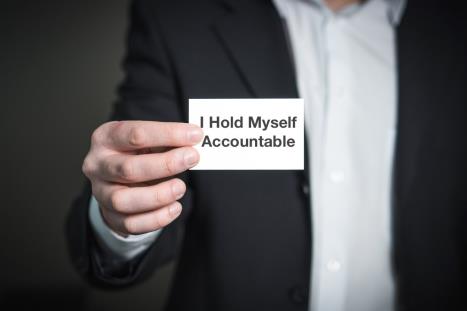How to Build a Culture of Accountability
A culture of accountability is an organization of accountable employees. Results are communicated and understood by everybody. Accountability is determined proactively, before the fact, not reactively, after the fact. When a mistake is made, the response is not finger pointing and excuses – it is about solving the problem and learning from mistakes. Every employee feels a sense of ownership for organizational results and will do what it takes to achieve those results.
So, what can leaders do to encourage a culture of accountability?
Walk the Talk
Nowadays, organizations are so afraid of lawsuits that they won’t admit mistakes. That kind of excuse making and blaming others will cascade down and permeate throughout the organizations. When a leader can stand before their employees and say “I made a mistake – and this is what we’re going to do to fix it” it sets a positive example of accountable behavior that employees won’t be afraid to emulate.
Define Results and Expectations
Don’t wait for a mistake to happen and then waste energy finding who is to blame. Instead, set clear standards and expectations before the work even starts. Then, make sure all employees are aware of and understand what results the organization is trying to achieve and what the expectations are for all employees. Every employee should have a “line of sight” to the organization’s desired results.
Gain Commitment
Without commitment, we get compliance or even resistance. “I’ll try” is not commitment. Ask: “Do I have your commitment?”, and listen to any concerns. Work with the employee to overcome barriers and figure out what needs to do to obtain their commitment.
Be Open to Feedback and Problem Solving
In other words, never “shoot the messenger”. Have an open-door environment where any employee is empowered to bring any problem to anyone in the organization without fear of repercussion.
Coach Employees on How to Be Accountable
Many individuals come from backgrounds where they never had to be accountable. They are used to awards for 5th place. They may have to learn new skills and behaviors, like critical thinking and problem before they can begin to thrive in a culture of accountability.
Hold Each Other Accountable
In a culture of accountability, leaders don’t just hold employees accountable for results. Everyone holds everyone accountable! Every employee takes ownership of organizational results, not just their own little part of the world. Again, leaders can role model, teach, and reinforce this kind of ownership mentality.

How to Create a Culture of Accountability in the Workplace?
Below are some of accountability in the workplace examples that constitute the most effective ways of getting employees to take ownership and promote your company’s definition of accountability in the workplace.
Below are 4 questions and exercises to do with teams and departments as you determine how to establish accountability for employees in your workplace:
- How to be accountable and demonstrate it at work (or in a given role or task)?
- How to take ownership of your work?
- How to instill a culture of accountability?
- How do responsibility and accountability impact role’s?
After getting together as a team to determine and define accountability and success at your organization, you work has only started

Set clear and measurable goals/expectations.
If you are going to hold employees accountable for delivering results, be explicit about exactly what results you expect. It can be helpful to involve the employee in the process. When employees feel they’ve helped in setting the goals, a sense of buy-in results. While SMART goals (specific, measurable, achievable, results-focused and time- bound) have been around for more than 30 years, they are still an effective management tool. With this tool, goals or expectations should be:
- Written — If you don’t write your expectations down, the chance for a misunderstanding of exactly what the goal is, increases exponentially.
- Specific and measurable — Broad generalizations such as “Improve performance” are not helpful. “Achieve sales of $1.3 million” is a much better goal. It is a specific, measurable goal, not open to interpretation. There can be no disagreement regarding whether the employee achieved such a goal.
- Achievable with effort — Goals that are too easy to attain aren’t useful. They will not drive performance. Goals that are unattainable will frustrate rather than motivate employees. Employees should see the goals as a real stretch, but achievable.
- Relevant — Ensure that goals are aligned with one other. They should also be aligned with the company’s overall goals and with the goals of other employees.
- Time- and resource-constrained — Be clear regarding when the goal must be achieved and the resources that the employee can use. Growing annual sales by 10 percent may be a wonderful goal, but if the employee achieves this by hiring six new salespeople or spending a million dollars on advertising, the cost may exceed the benefit.

Here’s How to Keep Yourself Accountable
The solution for finishing things: Create accountability through a buddy.
Accountability buddies can help us make meaningful progress. Surrounding ourselves with people invested in our success is the best way to make progress on our goals. Follow these steps to set up an accountability buddy.
1. Create a schedule and commit.
Decide how frequently you’ll meet. Once a week is a good starting point. You’ll have time to get things done in between your meetups (either in person or on the phone), but not so long that you start procrastinating or forgetting what you agreed to.
Then set a time and commit. Put it on your calendar and don’t let anything get in the way.
2. Help your buddy (and yourself) set better goals.
When we have a broad goal like “get healthy,” the failure comes in not knowing where to start. What do we do this month, this week, today, to make that happen?
If we can’t answer that simply, how are we supposed to act on it? Create SMART objectives that follow these guidelines:
- Specific
- Measurable
- Attainable
- Relevant
- Time-oriented
3. Be honest with each other.
My friend recently told me about an event he attended. A group of women were brought in to give direct feedback about how they perceived a group of men’s clothing and demeanor.
Try to imagine what happened.
“The guys were crying,” my friend said. “Nobody had ever given us this kind of brutal feedback.” My friend realized he’d never before received brutally honest feedback on how he interacted with women.
We should subject ourselves to uncomfortable situations where we take on the “beginner’s mind” and force ourselves to grow. An accountability buddy gives us the rare opportunity for brutal honesty.
4. Ask great questions.
Smart people ask questions because they know it’s the best way to get to the true heart of a matter.
When you say you were too busy to work out this week, what are you really saying?
Chances are you had time to watch Netflix or go out for drinks, so what really held you back? Maybe you were nervous about walking into a new gym.
By asking great questions, you and your accountability buddy can break through invisible barriers.
5. Gamify accountability with your friends.
I love bets. There are myriad psychological studies about public commitment, which is highly persuasive. If you tell a group of people you’re going to stop smoking, you’re highly motivated to hit that goal.
You can do this with your accountability buddy, too. If you each set a goal, bet who will hit it first. Or you can keep score of who completes more of their weekly tasks. Make it fun!
Building Your Accountability Skillset:
Step 1: Set some goals to develop your skillset.
I’m going to prove to myself and others that I’m fully responsible for the quality of my current work, before asking for more responsibility.
I’m going to define areas where I’m weak, could use training, or need support, and then develop an action plan to fill those gaps.
I’m going to develop my own working process that others can rely on.
- Define what needs to be done, why it needs to be done, when it needs to be done, who is involved and how the result will impact individuals, groups and the business.
- Commit to the work, the timeline and the result.
- Communicate that commitment to all involved. (via email, team meetings, phone calls, casual discussion)
- Communicate progress and results on a consistent and frequent basis to all involved.
Step 2: Hold yourself accountable for your results.
Take ownership of understanding your role, your goals and responsibilities.
Take ownership of understanding the roles, goals and responsibilities of those around you so you can work effectively with others.
Take ownership of your progress so that you can identify risks and do what needs to be done to mitigate or overcome roadblocks before they impact your work.
Step 3: Be consistent in your approach.
Use this skillset as often as possible so that others learn to expect it from you and trust you to work in this manner no matter whom you are working with.
Step 4: Coach & mentor others.
If you manage others, coach & mentor them through the first three steps.